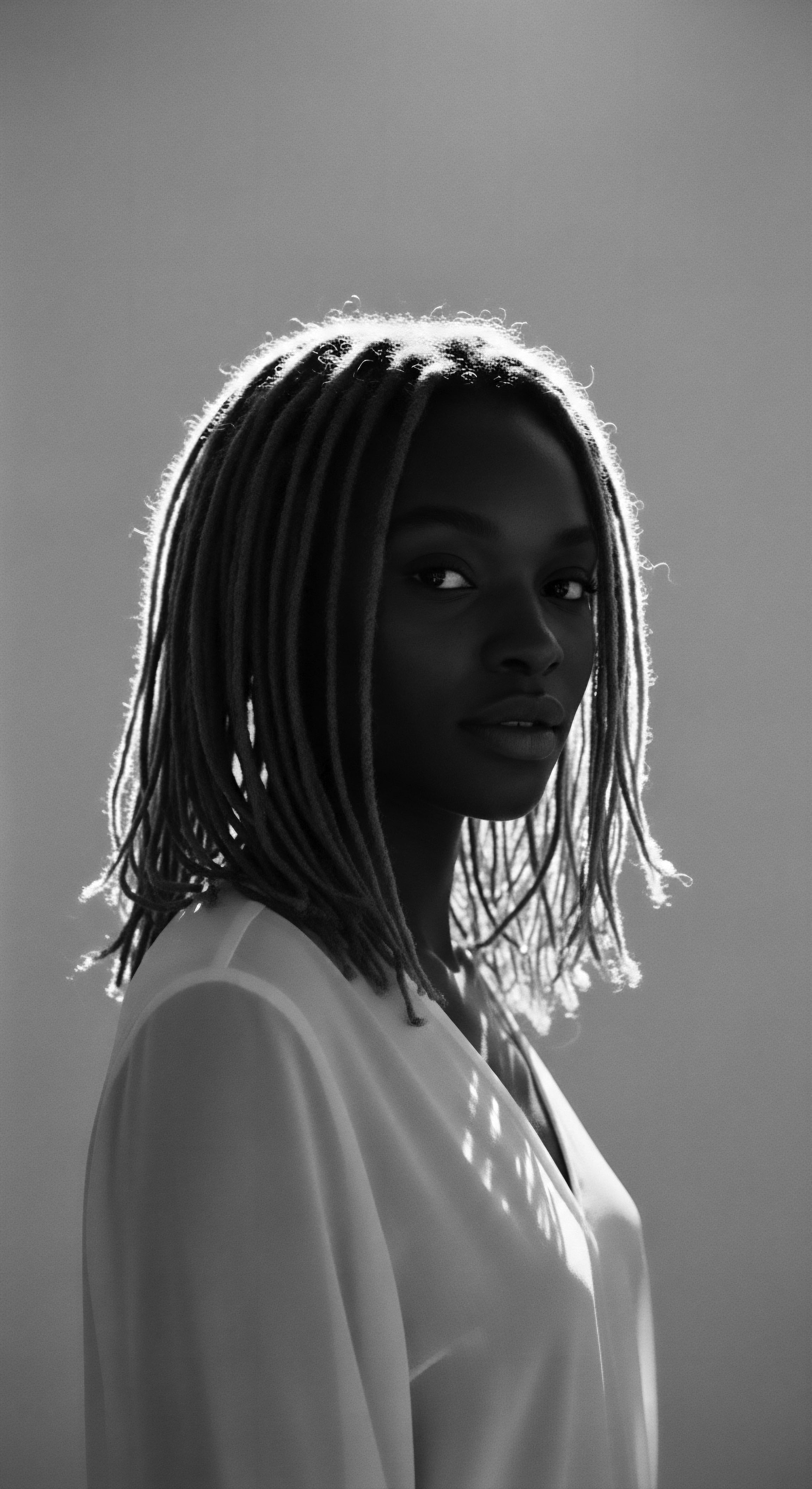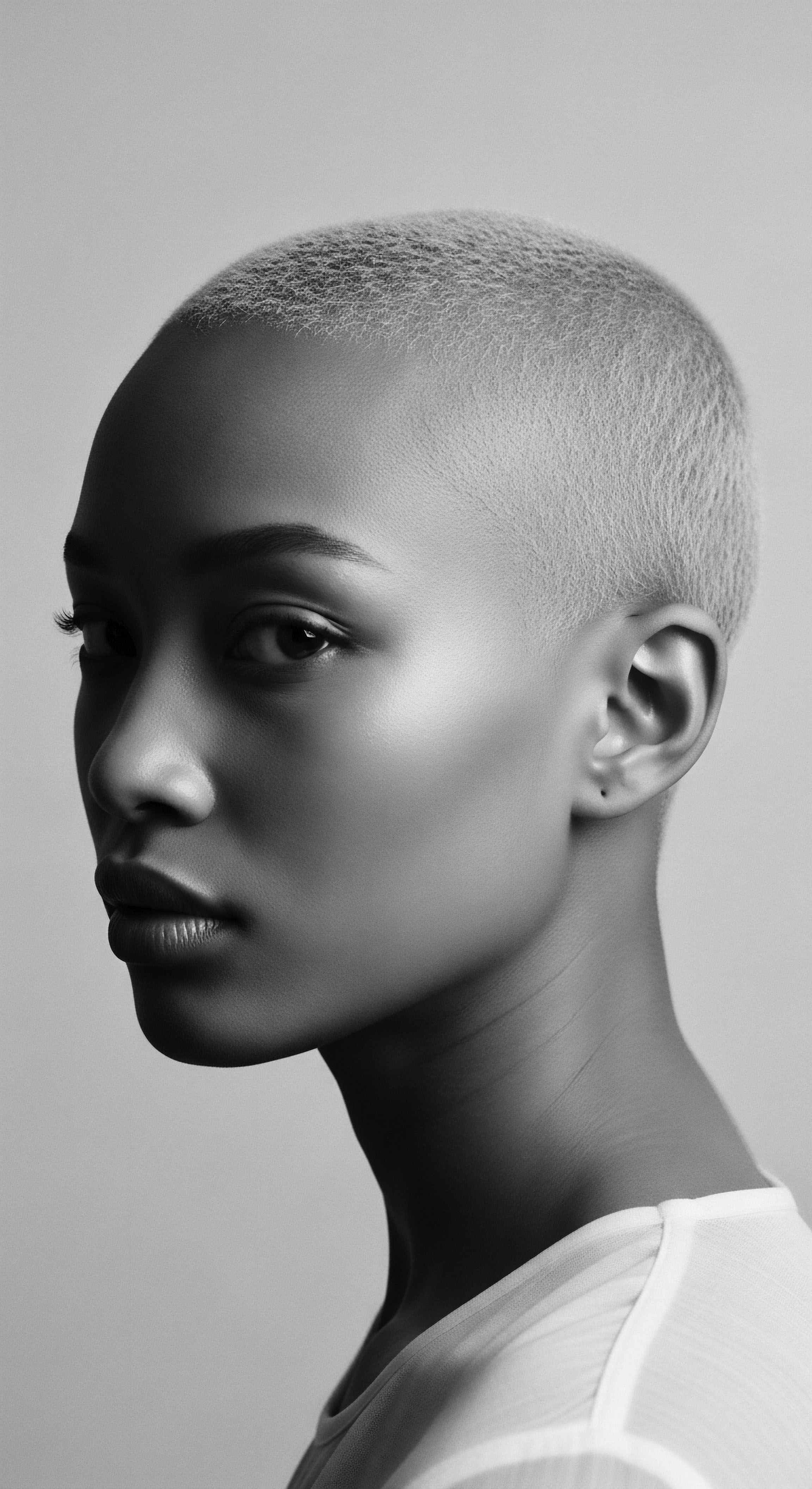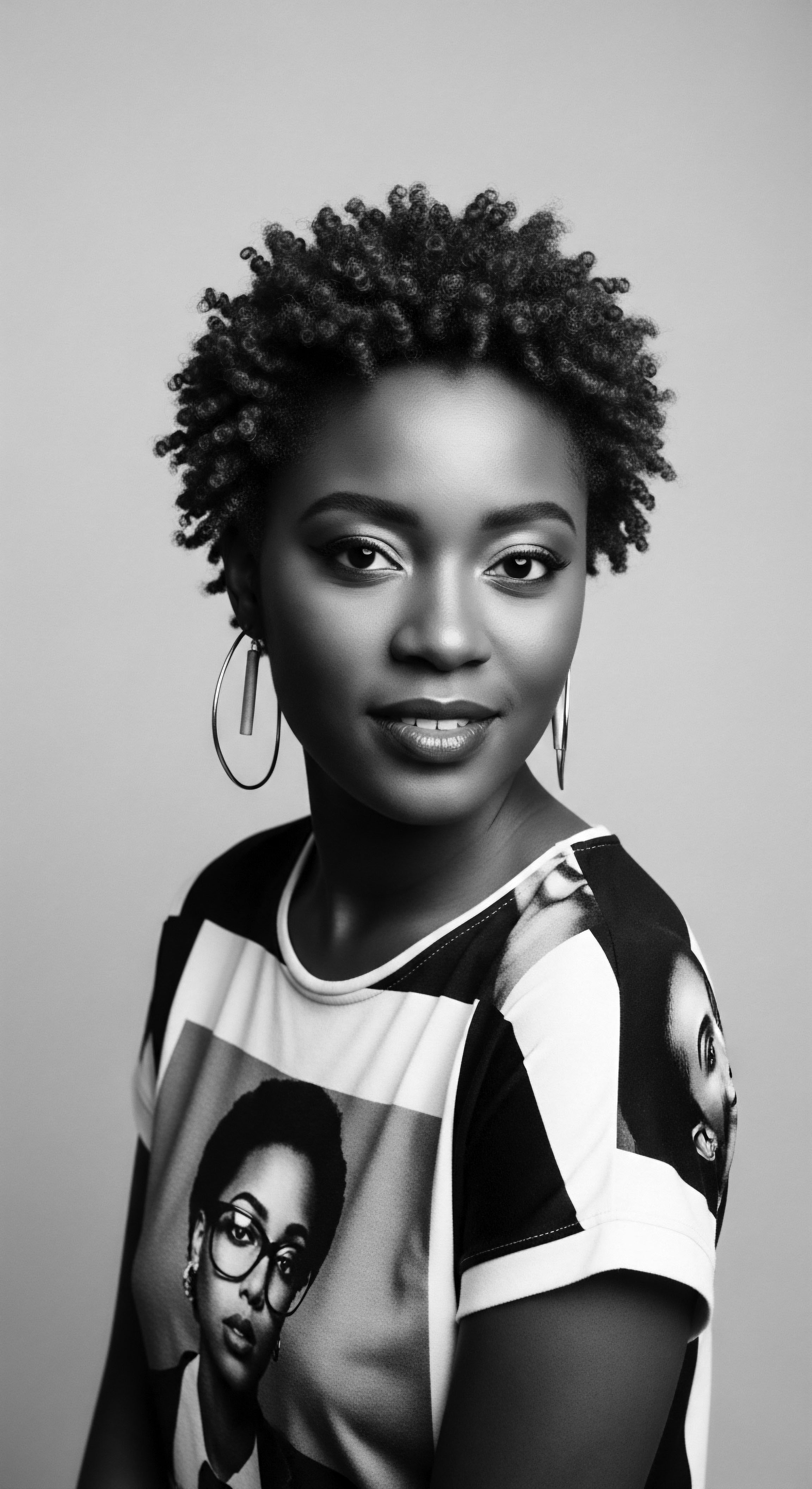
Roots
The very strands that crown us, rich with their spirals and coils, carry within their helix the murmurs of ancestral wisdom. They are not merely protein structures, but living archives, holding stories whispered across generations, across oceans. Consider the head covering, then, not as a simple adornment, but as a tender extension of this inherent narrative, a profound layer of communication woven into the very fabric of West African life and, by lineage, into the textured hair heritage that breathes through us today. We gaze upon these wrappings, these sacred cloths, and see beyond their vibrant hues; we perceive the deep currents of being, the silent languages spoken by fiber and form.
Our understanding of textured hair, from its elemental biology to the names we speak for its distinct patterns, is shaped by a history profoundly interconnected with the meanings held within head coverings. These coverings often served as a protector for the hair’s unique structural integrity, shielding it from harsh sun and dust, certainly, but also from the gaze of those who sought to diminish its inherent glory. The very act of wrapping, of concealing, paradoxically asserted a quiet power, a sense of self-possession that spoke volumes without a single uttered word.

Echoes from the Source
Across the expanse of West Africa, where diverse ethnic groups flourished, head coverings were not arbitrary stylistic choices. Their presence, their absence, their material, and their manner of tying conveyed a rich vocabulary. Think of the Gele of the Yoruba people, a headwrap whose complex folds could telegraph a woman’s marital status, her wealth, or even her mood. These were not casual acts of dressing, but deliberate presentations of self, deeply rooted in a shared cultural understanding of appearance as communication.
The head wrap, in many instances, became an extension of the cranial contours and the hair beneath, shaping a silhouette that held societal weight. This connection to the very anatomy and physiology of textured hair is subtle yet significant; the hair’s natural volume and resilience often dictated the drape and height of these magnificent creations, allowing for dramatic, sculptural statements.
The historical lexicon surrounding textured hair in West Africa often intertwines with practices of adornment and protection. Terms for hair textures, for example, were not always clinical classifications but often descriptive of how hair responded to styling or its symbolic qualities. The head covering, then, often completed a visual sentence, with the hair as its opening clause.
The act of tying a head covering, often a communal ritual, also protected various traditional hairstyles, preserving their integrity through daily activities and sleep. This ritualistic care, passed down through matriarchal lines, became a foundational aspect of hair health, ensuring the hair’s continued vitality in a land often unforgiving to unprotected strands.
West African head coverings communicated complex social, spiritual, and personal narratives, acting as extensions of textured hair’s inherent cultural power.

Anatomical Reverence and Practicality
The particular helical structure of textured hair, with its unique bends and coils, renders it susceptible to environmental factors like dust, sun exposure, and friction. In West Africa, where daily life often unfolded outdoors under intense sun, head coverings were not just ceremonial but also practical, offering a vital shield. Consider the nomadic Tuareg, whose Tagelmust serves as protection from the desert’s harsh elements, enveloping both head and often face. While not exclusively about textured hair, the principle of environmental protection is deeply ingrained, allowing for the maintenance of hair and scalp health.
The practical implications of these coverings allowed for hair to be styled in ways that could be preserved for longer periods, reducing manipulation and promoting growth. This practical protection became a foundation for the aesthetic and spiritual meanings they acquired over centuries.
Our ancestors understood the hair’s vulnerability. They instinctively knew that covering could mean preservation. This traditional knowledge often validated what modern trichology now affirms about protecting the cuticle and minimizing moisture loss. Head coverings in West Africa were, in a sense, among the earliest forms of “protective styling,” long before the term entered contemporary hair vocabulary.
They allowed for intricate braided or twisted styles to remain undisturbed, promoting length retention and reducing breakage. The relationship between hair growth cycles and these protective measures becomes clear; by safeguarding the hair, growth could progress unimpeded, a silent testament to the efficacy of these ancestral practices.
| Meaning Category Status and Rank |
| Historical Manifestation (Examples) Height and intricacy of wraps (e.g. Yoruba Gele, Ashanti head ties) often denoted social standing, age, or marital status. Specific fabrics and colors were reserved for royalty or elders. |
| Connection to Textured Hair Heritage The volume and resilience of textured hair allowed for dramatic, sculptural headwrap styles that visibly amplified social messages. The hair itself was often a canvas for elaborate coiffures revealed or concealed. |
| Meaning Category Protection and Health |
| Historical Manifestation (Examples) Shielding from sun, dust, and environmental elements. Maintaining scalp health and cleanliness, preserving intricate hairstyles. |
| Connection to Textured Hair Heritage Textured hair's natural dryness and fragility benefit greatly from protection against external aggressors, a practice intuitively understood and implemented through head coverings, promoting hair longevity. |
| Meaning Category Spirituality and Ritual |
| Historical Manifestation (Examples) Coverings worn during ceremonies, rites of passage, or for religious devotion. Certain patterns or colors held sacred meaning, guarding the spiritual purity of the wearer. |
| Connection to Textured Hair Heritage Hair's spiritual significance in many West African cultures (as a conduit to the divine, a source of power) was underscored by its covering, signifying reverence, humility, or spiritual readiness. |
| Meaning Category Identity and Group Affiliation |
| Historical Manifestation (Examples) Specific styles or fabrics unique to an ethnic group, community, or family lineage (e.g. Igbo, Fulani, Ewe). |
| Connection to Textured Hair Heritage Head coverings acted as a visual identifier of one's origins and belonging. The interplay between unique hair textures and traditional wraps strengthened collective identities. |
| Meaning Category These ancient practices lay the ground for contemporary understandings of textured hair, its value, and its protective needs. |

Ritual
The rhythmic motion of hands smoothing fabric, the careful folding and tying, the securing of a head covering—these were, and remain, acts steeped in ritual. In West Africa, these practices were rarely casual. They were imbued with purpose, with intention, connecting the wearer to their lineage, their community, and the spiritual dimensions of existence. This deep connection to ritual is where the head covering truly comes alive as a medium for communicating complex cultural meanings, especially in relation to the dynamic nature of textured hair.
Head coverings served as a silent language, a visual lexicon understood by those within a community. They could proclaim joyous occasions, signify a woman’s passage into marriage, or quietly express a state of mourning. The very way a cloth was folded, its height, its tilt, could convey messages subtle yet profound.
This was the art of daily life, where textiles became canvases for identity and tradition. For textured hair, which held immense symbolic weight in these societies, the head covering was not just a protective barrier but also a ceremonial crown, framing or concealing, always with intention.

Styling Practices and Ancestral Roots
Many traditional West African hairstyles, often intricate and time-consuming to create, found their preservation in head coverings. A woman might spend hours braiding her hair into complex patterns—styles that could represent constellations, historical events, or social status. The headwrap then acted as a crucial element of Protective Styling, guarding these artistic expressions from the elements and allowing them to last for days or even weeks.
This careful preservation speaks to a profound respect for the labor and artistry involved in hair creation, as well as a practical approach to hair care in communal settings. It was a recognition that caring for one’s hair was an investment of time, skill, and cultural devotion.
Consider the Gele of the Yoruba people, which can vary from simple, utilitarian wraps to monumental architectural statements. The complexity of a gele often signifies the wearer’s social standing or the significance of the occasion. A woman attending a celebratory event might wear a gele tied with such height and dramatic flair that it demands attention, a testament to her family’s prosperity and her own dexterity. This intricate dance between hair, textile, and identity reveals how head coverings were not merely accessories but foundational elements of an entire aesthetic system, deeply intertwined with the hair’s natural texture and volume.
(Hale, 1998, p. 132)
The practice of wrapping the head was a daily ritual, communicating social status, spiritual reverence, and personal identity through the language of fabric and form.

A Sacred Envelopment
Beyond the aesthetic and social, head coverings carried immense spiritual weight. In many West African belief systems, the head is considered a sacred conduit, the seat of one’s spiritual essence, where the divine connects with the individual. Covering the head, therefore, was often an act of reverence, a way to honor and protect this vital spiritual link. During religious ceremonies, rites of passage, or moments of deep spiritual contemplation, specific head coverings would be worn, their materials and patterns often bearing symbolic significance.
For instance, among some communities, certain cloths with specific patterns or colors were worn during funerals or periods of mourning, signifying grief and respect for the departed. These weren’t mere stylistic choices but profound cultural expressions of internal states, made manifest through external adornment. This layering of meaning, from the mundane protection against dust to the sacred act of spiritual safeguarding, underscores the multifaceted role of head coverings in West African societies. The hair beneath these coverings was often viewed as a spiritual antenna, its protection through careful wrapping ensuring a clear connection to ancestral wisdom and divine guidance.
The careful selection and tying of head coverings were passed down through generations, often as a shared tradition between women. This intergenerational transfer of knowledge ensured that the meanings embedded in these practices were maintained, reinforcing communal bonds and a collective understanding of heritage. The wisdom extended not just to the wrapping technique, but to the care of the hair beneath, integrating the covering into a holistic regimen for maintaining radiant, healthy textured hair.
- Material Choices ❉ Cotton, silk, mudcloth, and indigo-dyed fabrics were chosen not only for beauty but for breathability and protective qualities for hair.
- Symbolic Patterns ❉ Geometric designs, animal motifs, and ancestral symbols printed or woven into fabrics conveyed specific tribal affiliations, proverbs, or spiritual beliefs.
- Stylistic Variation ❉ The height, asymmetry, and number of layers in a head covering communicated nuanced messages about the wearer’s status, occasion, or personal disposition.

Relay
The cultural meanings conveyed by head coverings in West Africa are not static historical relics; they are living narratives, constantly relayed and reinterpreted across time and space. They form a foundational pillar of identity, particularly within the textured hair heritage that extends globally, connecting the diaspora back to its ancestral roots. Understanding these deeper layers requires a consideration of how these practices survived, transformed, and continue to speak volumes in contemporary contexts, often as powerful statements of resilience and self-affirmation.
The head covering, in its myriad forms, has become a potent symbol of ancestral connection for Black and mixed-race communities worldwide. When we observe the resurgence of head wraps in modern fashion, or the thoughtful adoption of traditional headwear in daily life, we witness a conscious invocation of heritage. This is not merely fashion; it is an act of reclaiming, a visual dialogue with history, a way of anchoring oneself in a lineage that prized self-expression and identity through hair and adornment.

Identity and Resistance in the Diaspora
The transference of head-covering traditions from West Africa to the diaspora, especially during the transatlantic slave trade, carries a profound history of both continuity and subversion. In the face of brutal dehumanization, head coverings, once symbols of status and spirituality, became quiet acts of resistance. Enslaved African women, stripped of so much, held onto the practice of wrapping their heads, using what little fabric they had to maintain a semblance of dignity, identity, and connection to their heritage. This persistence, often under the most oppressive conditions, transformed the head covering into a powerful emblem of survival.
However, colonial powers and later oppressive regimes often sought to control or outlaw these coverings, recognizing their power to communicate defiance and cultural cohesion. For instance, the Tignon Laws enacted in Louisiana in the late 18th century mandated that Black and mixed-race women wear a tignon (head covering) to conceal their hair, particularly their elaborate hairstyles. The intent was to diminish their attractiveness and social standing. Yet, in an astonishing act of defiance, these women transformed the forced tignon into a fashion statement, using vibrant fabrics and elaborate tying methods that made them even more striking, turning an instrument of oppression into a symbol of resilience and artistry.
(White, 2010, p. 177) This historical example powerfully illuminates how cultural meanings can be twisted, resisted, and ultimately re-appropriated, becoming even more potent in their reassertion of identity.
Head coverings have served as a resilient visual language, adapting through historical adversities to convey enduring identity and ancestral connection.

The Head Covering as Cultural Preservation
Today, head coverings serve as a bridge between the past and the present. For many, wearing a head wrap is a conscious decision to honor ancestors, to express cultural pride, and to celebrate the unique beauty of textured hair. This act goes beyond mere aesthetics; it is a wellness practice, a way of protecting fragile strands, yes, but also a spiritual balm, connecting the wearer to a deeper sense of self and community. The choice to cover one’s hair, whether for everyday wear or special occasions, reaffirms a lineage where hair held spiritual, social, and aesthetic power.
This continuation of ancestral practices also allows for a modern dialogue with traditional forms. Designers and artists today draw inspiration from historical West African headwear, reinterpreting ancient styles for contemporary audiences. This creative dialogue ensures that the knowledge and meanings embedded within these practices are not lost but rather continuously revitalized and shared. It encourages a deeper appreciation for the ingenuity of past generations in developing sustainable and culturally rich hair care and adornment practices.
- Ceremonial Significance ❉ Head coverings are still donned for weddings, naming ceremonies, and funerals, maintaining their sacred roles in life’s passages.
- Daily Assertion ❉ Many individuals choose head wraps as an everyday statement of cultural belonging, aesthetic preference, or simply to protect their hair.
- Global Resurgence ❉ The head wrap has gained popularity globally, fostering cross-cultural appreciation while maintaining its core resonance for those with ancestral ties.

The Unbound Helix and Future Expressions
How do these historical meanings continue to shape our futures, particularly concerning textured hair? The head covering’s journey from elemental protection to complex social messaging, and then to a symbol of diasporic resistance, informs our understanding of hair as a profound medium of identity. It teaches us that our hair is never simply hair; it is a declaration, a history, a prayer. The ongoing legacy of West African head coverings reminds us that care for textured hair extends beyond conditioners and oils; it involves a reverence for its historical trajectory, its spiritual weight, and its capacity to connect us to a collective consciousness.
The meanings conveyed by head coverings in West Africa serve as a powerful testament to the ingenuity and resilience of our ancestors. They offer a framework for understanding how appearance, culture, and individual identity intertwine, particularly in the context of textured hair. This heritage continues to speak to us, urging us to recognize the profound messages held within every strand and every careful fold of fabric.

Reflection
To walk this path, tracing the lineage of West African head coverings, is to walk alongside the very soul of a strand. Each fiber of cloth, each twist and tie, holds within it the whispers of generations, a silent testament to the enduring spirit of textured hair heritage. This journey through cultural meanings – from the practical shield against the sun’s ardor to the intricate semaphore of status and spirit – reveals that head coverings were never simply external adornments. They were, and remain, a profound extension of self, a vibrant narrative woven into the very being of Black and mixed-race peoples.
As we look upon these echoes from the source, we do not merely observe history; we recognize ourselves, our resilience, our unwavering connection to ancestral wisdom that continues to shape our radiance today. The legacy of these coverings urges us to recognize the hair not as an isolated entity but as a living part of a vast, interconnected cultural tapestry, a heritage that pulses with life, beauty, and unwavering significance.

References
- Hale, Thomas A. Griots and Griottes ❉ Masters of Words and Music. Indiana University Press, 1998.
- White, Shane. Stylin’ ❉ African American Expressive Culture from Its Beginnings to the Zoot Suit. Cornell University Press, 2010.
- Drewal, Henry John, and Margaret Thompson Drewal. Gelede ❉ Art and Female Power Among the Yoruba. Indiana University Press, 1983.
- Perani, Judith, and Fred T. Smith. African Textiles ❉ Color and Creativity Across a Continent. George Braziller, 1999.
- Picton, John, and John Mack. African Textiles. British Museum Press, 1989.
- Kriger, Colleen E. Cloth in West African History. Rowman & Littlefield Publishers, 2017.
